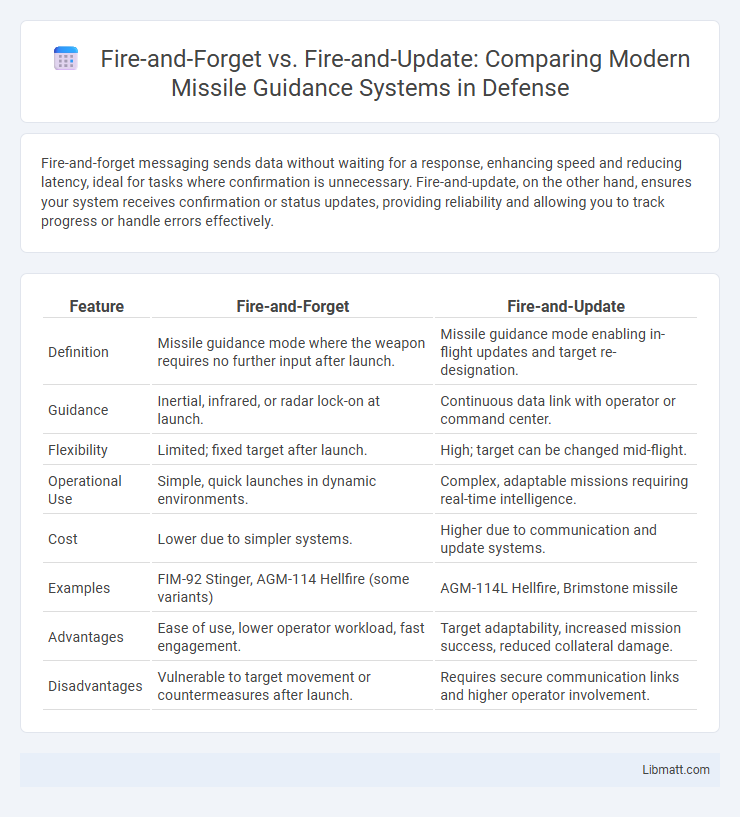Fire-and-forget messaging sends data without waiting for a response, enhancing speed and reducing latency, ideal for tasks where confirmation is unnecessary. Fire-and-update, on the other hand, ensures your system receives confirmation or status updates, providing reliability and allowing you to track progress or handle errors effectively.
Table of Comparison
| Feature | Fire-and-Forget | Fire-and-Update |
|---|---|---|
| Definition | Missile guidance mode where the weapon requires no further input after launch. | Missile guidance mode enabling in-flight updates and target re-designation. |
| Guidance | Inertial, infrared, or radar lock-on at launch. | Continuous data link with operator or command center. |
| Flexibility | Limited; fixed target after launch. | High; target can be changed mid-flight. |
| Operational Use | Simple, quick launches in dynamic environments. | Complex, adaptable missions requiring real-time intelligence. |
| Cost | Lower due to simpler systems. | Higher due to communication and update systems. |
| Examples | FIM-92 Stinger, AGM-114 Hellfire (some variants) | AGM-114L Hellfire, Brimstone missile |
| Advantages | Ease of use, lower operator workload, fast engagement. | Target adaptability, increased mission success, reduced collateral damage. |
| Disadvantages | Vulnerable to target movement or countermeasures after launch. | Requires secure communication links and higher operator involvement. |
Introduction to Fire-and-Forget and Fire-and-Update
Fire-and-forget is an asynchronous communication pattern where a message is sent without waiting for a response, ensuring minimal latency and lightweight processing. Fire-and-update extends this concept by allowing the sender to receive status updates or progress reports after the initial message is sent, combining asynchronous behavior with feedback mechanisms. Understanding these patterns can optimize your system's performance by balancing speed and informational needs.
Defining Fire-and-Forget in Modern Applications
Fire-and-forget in modern applications refers to an asynchronous communication pattern where a system sends a request or command without waiting for a response or confirmation, prioritizing speed and resource efficiency. This approach is commonly used in event-driven architectures, messaging systems, and microservices to offload tasks and improve scalability by decoupling components. Key examples include logging events, sending notifications, and initiating non-critical background processing where immediate feedback is not required.
Exploring Fire-and-Update Mechanisms
Fire-and-update mechanisms enable systems to send a message and receive a confirmation or updated status without blocking the main process, enhancing efficiency and reliability. These mechanisms are crucial in applications requiring real-time feedback, such as IoT devices or asynchronous APIs, where continuous state synchronization is needed. Your applications benefit from reduced latency and improved user experience when integrating fire-and-update over fire-and-forget strategies.
Key Differences: Fire-and-Forget vs Fire-and-Update
Fire-and-Forget processes initiate an action without awaiting any response, prioritizing speed and resource efficiency by not monitoring outcomes. Fire-and-Update, in contrast, involves sending a request while actively tracking the response to update the system state or handle errors, which enhances reliability but increases complexity and resource usage. Key differences include response handling, system feedback incorporation, and the trade-off between performance and robustness in asynchronous operations.
Use Cases for Fire-and-Forget
Fire-and-forget messaging is ideal for scenarios where immediate response is unnecessary, such as logging events or sending notifications, ensuring system efficiency by offloading tasks without waiting for acknowledgments. In distributed systems, it supports decoupled communication by allowing producers to dispatch messages rapidly to consumers without blocking processes. Use cases also include telemetry data reporting and asynchronous task triggering, where the outcome does not affect the primary workflow.
Scenarios Best Suited for Fire-and-Update
Fire-and-update is best suited for scenarios requiring continuous synchronization between distributed systems, such as real-time data replication or stateful event processing. It ensures data consistency by confirming the receipt and successful processing of events, critical in financial transaction reconciliation or collaborative applications. Systems needing reliable delivery guarantees and the ability to handle updates or corrections also benefit significantly from the fire-and-update approach.
Performance Implications and Trade-offs
Fire-and-forget operations offer lower latency and reduced resource consumption by sending requests without awaiting responses, making them ideal for high-throughput systems with limited need for feedback. Fire-and-update ensures data consistency and error handling through acknowledgment and potential retries, but introduces overhead that can degrade performance under heavy loads. Choosing between these approaches depends on balancing speed against reliability, where fire-and-forget favors efficiency and fire-and-update prioritizes accuracy and state synchronization.
Reliability and Error Handling Considerations
Fire-and-forget messaging prioritizes speed but sacrifices reliability, as it does not confirm message delivery or handle errors, leading to potential data loss or missed updates. Fire-and-update approaches enhance reliability by tracking message status and implementing retry mechanisms, ensuring that updates are applied even in case of failures. Effective error handling in fire-and-update systems includes logging, alerting, and compensating transactions to maintain data consistency and system integrity.
Choosing the Right Method for Your Architecture
Fire-and-forget is ideal when low latency and simplicity are priorities, as it allows your system to trigger processes without waiting for confirmation, reducing bottlenecks in distributed architectures. Fire-and-update suits scenarios requiring reliable data consistency and state synchronization, ensuring system components stay updated with process outcomes. Evaluating your architecture's need for responsiveness versus data accuracy helps determine whether fire-and-forget or fire-and-update best supports your application's performance and reliability goals.
Future Trends in Asynchronous Operations
Future trends in asynchronous operations emphasize the shift from traditional fire-and-forget models to fire-and-update mechanisms that enhance real-time feedback and error handling. Advanced event-driven architectures and serverless computing promote stateful updates, enabling systems to optimize resource allocation and improve user experience through continuous status notifications. Integration of AI-driven monitoring tools further refines asynchronous workflows by predicting potential failures and automating recovery processes.
Fire-and-forget vs Fire-and-update Infographic

 libmatt.com
libmatt.com